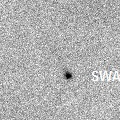
|
Bright new comet. Now it is 6.6 mag (Sept. 23, Chris Wyatt). It will fade out rapidly after this. In the Northern Hemisphere, it is not observable now, but it will appear in October. In the Southern Hemisphere, it will be getting higher gradually.
Date(TT) R.A. (2000) Decl. Delta r Elong. m1 Best Time(A, h)
Sept.20 13 42.46 -12 3.2 0.741 0.533 31 6.6 19:24 ( 77, -2)
Sept.27 14 18.16 -14 4.8 0.578 0.608 33 6.6 19:14 ( 72, 0)
|
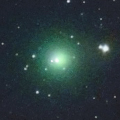
|
It brightened very rapidly. It is expected to brighten up to 4 mag from October to November. Now it is 7.3 mag (Sept. 23, Osamu Miyazaki). It brightens up to 4 mag, but it will turn to fade out rapidly after that. In the Northern Hemisphere, it will be getting lower gradually after this, and it will be unobservable in November. In the Southern Hemisphere, it is not observable now, but it will appear in December.
Date(TT) R.A. (2000) Decl. Delta r Elong. m1 Best Time(A, h)
Sept.20 8 43.89 36 1.9 1.417 1.179 55 8.5 4:21 (248, 37)
Sept.27 9 13.22 38 21.1 1.180 1.062 57 7.6 4:27 (246, 38)
|
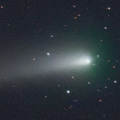
|
It is expected to brighten up to 7.5 mag in October. Now it is 10.6 mag (Sept. 16, Thomas Lehmann). It brightens up to 7.5 mag, but it will turn to fade out rapidly after that. In the Northern Hemisphere, it is not observable now, but it will appear in October. In the Southern Hemisphere, it will be unobservable in October.
Date(TT) R.A. (2000) Decl. Delta r Elong. m1 Best Time(A, h)
Sept.20 13 47.26 -13 2.4 1.128 0.611 32 9.8 19:24 ( 76, -3)
Sept.27 13 22.51 -14 12.2 1.233 0.469 21 8.9 19:14 ( 81,-12)
|

|
It brightened very rapidly. Now it is 14.4 mag (Sept. 17, Ken-ichi Kadota). It will turn to fade out rapidly after the peak. It will be fainter than 18 mag in November. In the Northern Hemisphere, it will be unobservable in October. In the Southern Hemisphere, it will never be observable after this.
Date(TT) R.A. (2000) Decl. Delta r Elong. m1 Best Time(A, h)
Sept.20 10 0.17 10 23.4 1.134 0.541 28 12.4 4:21 (264, 9)
Sept.27 10 39.04 2 52.2 1.242 0.524 24 12.3 4:27 (269, 4)
|
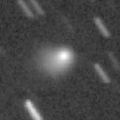
|
It is expected to brighten up to 5 mag in January. Now it is 13.1 mag (Sept. 21, Seiichi Yoshida). It will brighten rapidly after this. It will be unobservable in October in the Southern Hemisphere, or in December in the Northern Hemisphere.
Date(TT) R.A. (2000) Decl. Delta r Elong. m1 Best Time(A, h)
Sept.20 16 2.89 28 13.3 2.497 2.285 66 12.6 19:24 ( 95, 47)
Sept.27 16 7.98 24 57.3 2.461 2.187 62 12.4 19:14 ( 92, 44)
|

|
Third interstellar object in history following 1I/'Oumuamua and 2I/Borisov. The eccentricity is extremely big as 6. It approaches to Sun down to 1.38 a.u. in late October. Now it is 11.8 mag (Sept. 24, Michael Jager). It brightens up to 11 mag, but it will turn to fade out rapidly after that. It will be unobservable in October. But it will be observable again in November.
Date(TT) R.A. (2000) Decl. Delta r Elong. m1 Best Time(A, h)
Sept.20 14 47.35 -12 13.9 2.531 1.976 46 13.0 19:24 ( 67, 10)
Sept.27 14 33.28 -11 23.2 2.513 1.801 35 12.6 19:14 ( 73, 4)
|
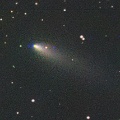
|
Now it is brighter than originally expected. Now it is 13.6 mag (Sept. 23, Osamu Miyazaki). It stays 13 mag for a while. It stays observable in good condition. It is expected to brighten up to 12 mag and to be observable in good condition from autumn to winter.
Date(TT) R.A. (2000) Decl. Delta r Elong. m1 Best Time(A, h)
Sept.20 4 10.28 -0 45.9 1.625 2.238 114 13.1 4:15 ( 0, 54)
Sept.27 4 13.68 -0 27.7 1.544 2.222 120 12.9 3:51 ( 0, 55)
|

|
Now it is 13.9 mag (Sept. 23, Osamu Miyazaki). It stays 14 mag for a while. In the Northern Hemisphere, it stays observable in good condition. It locates somewhat low in the Southern Hemisphere.
Date(TT) R.A. (2000) Decl. Delta r Elong. m1 Best Time(A, h)
Sept.20 3 34.96 25 55.9 3.261 3.851 119 13.4 3:40 ( 0, 81)
Sept.27 3 36.04 26 10.2 3.188 3.858 125 13.4 3:14 ( 0, 81)
|

|
It is expected to brighten up to 8 mag from late autumn to early winter. Now it is 17.2 mag (Sept. 17, ATLAS South Africa). Brightening rapidly. It will be unobservable in October in the Northern Hemisphere, or in November in the Southern Hemisphere. But it will be observable again in November in the Northern Hemisphere, or in December in the Southern Hemisphere. It is much fainter than this ephemeris recently.
Date(TT) R.A. (2000) Decl. Delta r Elong. m1 Best Time(A, h)
Sept.20 19 1.82 -41 43.3 0.604 1.294 104 14.6 19:24 ( 4, 13)
Sept.27 18 40.49 -41 58.2 0.587 1.196 93 14.0 19:14 ( 11, 12)
|

|
It is expected to brighten up to 13 mag in early summer in 2026. Now it is 14.4 mag (Sept. 12, Andrew Pearce). It stays 14 mag for a while. It will be getting lower gradually after this, and it will be unobservable in January in the Northern Hemisphere, or in November in the Southern Hemisphere.
Date(TT) R.A. (2000) Decl. Delta r Elong. m1 Best Time(A, h)
Sept.20 19 44.78 14 21.7 3.456 4.022 117 14.2 19:47 ( 0, 69)
Sept.27 19 36.71 12 35.6 3.531 3.994 110 14.3 19:14 ( 2, 68)
|
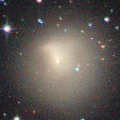
|
Now it is not observable. It will appear in October.
Date(TT) R.A. (2000) Decl. Delta r Elong. m1 Best Time(A, h)
Sept.20 10 50.46 3 13.5 7.261 6.295 14 14.3 4:21 (263, -5)
Sept.27 10 55.05 2 40.5 7.228 6.296 20 14.3 4:27 (267, 0)
|

|
Now it is 14.6 mag (Sept. 7, Ken-ichi Kadota). It stays 15 mag for a while. It will be unobservable in October in the Southern Hemisphere, or in November in the Northern Hemisphere. But it will be observable again in December in the Northern Hemisphere.
Date(TT) R.A. (2000) Decl. Delta r Elong. m1 Best Time(A, h)
Sept.20 15 30.46 -0 54.9 6.254 5.745 55 14.3 19:24 ( 69, 25)
Sept.27 15 35.05 -1 0.3 6.360 5.771 50 14.4 19:14 ( 71, 23)
|

|
Now it is 15.7 mag (Sept. 19, Francois Kugel). It stays 15 mag for a while. In the Northern Hemisphere, it will be getting higher gradually. It locates somewhat low in the Southern Hemisphere.
Date(TT) R.A. (2000) Decl. Delta r Elong. m1 Best Time(A, h)
Sept.20 8 46.31 18 47.8 6.097 5.476 48 14.8 4:21 (266, 29)
Sept.27 8 51.89 18 52.3 6.012 5.477 53 14.8 4:27 (270, 34)
|

|
It will brighten up to 13 mag in 2026. Now it is 15.0 mag (Sept. 11, Andrew Pearce). It stays 15 mag for a while. It will be getting lower gradually after this, and it will be unobservable in January in the Northern Hemisphere, or in November in the Southern Hemisphere.
Date(TT) R.A. (2000) Decl. Delta r Elong. m1 Best Time(A, h)
Sept.20 18 31.50 -11 56.9 5.042 5.321 100 15.0 19:24 ( 16, 42)
Sept.27 18 31.07 -11 31.5 5.119 5.282 93 15.0 19:14 ( 22, 41)
|
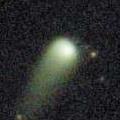
|
It was observed at 12-13 mag for a long time in 2024. Now it is 15.3 mag (Sept. 23, ATLAS-MLO, Mauna Loa). Fading slowly. In the Northern Hemisphere, it stays observable in good condition. In the Southern Hemisphere, it will be unobservable soon. But it will be observable again in September.
Date(TT) R.A. (2000) Decl. Delta r Elong. m1 Best Time(A, h)
Sept.20 23 47.79 55 2.8 4.263 4.892 123 15.0 23:48 (180, 70)
Sept.27 23 33.33 53 50.4 4.262 4.931 127 15.0 23:06 (180, 71)
|
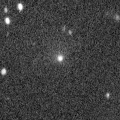
|
Very large comet. It is expected to brighten up to 13 mag in 2031. Now it is 15.0 mag (Aug. 31, Andrew Pearce). It stays 15 mag for a while. In the Northern Hemisphere, it is not observable now. In the Southern Hemisphere, it stays observable in good condition. In the Northern Hemisphere, it is not observable until 2030.
Date(TT) R.A. (2000) Decl. Delta r Elong. m1 Best Time(A, h)
Sept.20 5 40.80 -70 51.3 14.660 14.726 91 15.0 4:21 (353,-17)
Sept.27 5 42.10 -71 21.5 14.650 14.703 91 15.0 4:27 (356,-17)
|

|
Now it is 16.5 mag (Apr. 7, Alfons Diepvens). It stays 15 mag for a while. In the Northern Hemisphere, it will be getting higher gradually. It locates somewhat low in the Southern Hemisphere. But it will become high in winter.
Date(TT) R.A. (2000) Decl. Delta r Elong. m1 Best Time(A, h)
Sept.20 9 10.13 9 50.2 3.145 2.467 40 15.0 4:21 (271, 19)
Sept.27 9 22.16 8 37.4 3.095 2.474 43 15.0 4:27 (276, 23)
|

|
Now it is 17.7 mag (July 24, Thomas Lehmann). It will brighten rapidly after this. Now it is not observable. It will appear in January in the Southern Hemisphere, or in December in the Northern Hemisphere.
Date(TT) R.A. (2000) Decl. Delta r Elong. m1 Best Time(A, h)
Sept.20 12 43.20 -2 31.2 3.204 2.244 14 15.9 19:24 ( 93, -9)
Sept.27 12 55.75 -3 57.4 3.174 2.197 10 15.7 19:14 ( 93,-11)
|

|
Now it is 15.6 mag (Sept. 7, ATLAS-MLO, Mauna Loa). It stays 15 mag for a while. It stays extremely low in the Northern Hemisphere. In the Southern Hemisphere, it stays observable in good condition. It is expected to brighten up to 12 mag in winter between 2026 and 2027.
Date(TT) R.A. (2000) Decl. Delta r Elong. m1 Best Time(A, h)
Sept.20 3 23.29 -43 52.1 5.749 6.259 116 15.8 3:28 ( 0, 11)
Sept.27 3 21.76 -44 27.5 5.683 6.216 117 15.7 2:59 ( 0, 11)
|
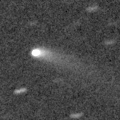
|
Now it is 15.5 mag (Sept. 3, Michael Jager). Fading slowly. It stays observable in good condition.
Date(TT) R.A. (2000) Decl. Delta r Elong. m1 Best Time(A, h)
Sept.20 22 51.97 -11 23.1 1.841 2.816 162 15.8 22:54 ( 0, 44)
Sept.27 22 47.26 -11 10.9 1.873 2.813 155 15.8 22:21 ( 0, 44)
|

|
It brightened up to 12.7 mag in 2024 summer (Aug. 7, 2024, Thomas Lehmann). Now it is 15.7 mag (Sept. 23, ATLAS-MLO, Mauna Loa). Fading slowly. In the Northern Hemisphere, it stays observable in good condition. In the Southern Hemisphere, it will never be observable after this.
Date(TT) R.A. (2000) Decl. Delta r Elong. m1 Best Time(A, h)
Sept.20 22 42.65 58 32.4 3.427 4.009 118 15.8 22:44 (180, 66)
Sept.27 22 35.16 58 13.9 3.468 4.064 120 15.9 22:09 (180, 67)
|
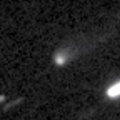
|
Now it is 15.7 mag (Sept. 14, J. Tapioles). Fading slowly. It will be unobservable in January.
Date(TT) R.A. (2000) Decl. Delta r Elong. m1 Best Time(A, h)
Sept.20 18 29.94 -31 41.2 2.630 2.965 99 15.8 19:24 ( 12, 22)
Sept.27 18 36.13 -31 28.3 2.728 2.970 93 15.9 19:14 ( 14, 22)
|

|
It is expected to brighten up to 13.5 mag and to be observable in good condition in 2026 spring. Now it is 16.8 mag (Aug. 12, ATLAS South Africa). Brightening slowly. In the Northern Hemisphere, it is not observable now, but it will appear in January. It locates somewhat low in the Southern Hemisphere. But it will become high in winter.
Date(TT) R.A. (2000) Decl. Delta r Elong. m1 Best Time(A, h)
Sept.20 12 16.43 -66 23.5 2.417 2.240 67 15.9 19:24 ( 29,-38)
Sept.27 12 46.94 -63 59.4 2.452 2.184 62 15.8 19:14 ( 32,-36)
|

|
It brightened up to 12.1 mag in early summer (June 10, Taras Prystavski). Now it is 15.5 mag (Sept. 14, Catalina Sky Survey). Fading gradually. It will be fainter than 18 mag in January. In the Northern Hemisphere, it stays observable in good condition. It locates somewhat low in the Southern Hemisphere. But it will become high in autumn.
Date(TT) R.A. (2000) Decl. Delta r Elong. m1 Best Time(A, h)
Sept.20 8 7.60 14 28.1 2.240 1.877 56 15.9 4:21 (276, 34)
Sept.27 8 19.75 14 4.1 2.229 1.934 60 16.1 4:27 (280, 39)
|

|
It will brighten up to 12 mag in 2026 summer. Now it is 16.2 mag (Sept. 18, Francois Kugel). Brightening slowly. In the Northern Hemisphere, it stays observable in good condition. In the Southern Hemisphere, it will be getting lower gradually after this, and it will be unobservable in January.
Date(TT) R.A. (2000) Decl. Delta r Elong. m1 Best Time(A, h)
Sept.20 19 50.71 -13 5.4 2.267 2.902 119 16.3 19:53 ( 0, 42)
Sept.27 19 51.50 -13 22.6 2.321 2.869 113 16.2 19:27 ( 0, 42)
|

|
Now it is 17.0 mag (Sept. 23, ATLAS-HKO, Haleakala). It stays 16 mag for a while. In the Northern Hemisphere, it stays observable in good condition. In the Southern Hemisphere, it will be unobservable in January.
Date(TT) R.A. (2000) Decl. Delta r Elong. m1 Best Time(A, h)
Sept.20 8 32.45 28 51.6 4.471 3.969 54 16.4 4:21 (258, 36)
Sept.27 8 37.35 29 57.4 4.382 3.983 60 16.4 4:27 (259, 42)
|

|
Now it is 16.2 mag (May 13, ATLAS South Africa). It stays 16 mag for a while. It will be getting higher gradually.
Date(TT) R.A. (2000) Decl. Delta r Elong. m1 Best Time(A, h)
Sept.20 8 36.14 -10 37.6 7.178 6.568 49 16.5 4:21 (294, 14)
Sept.27 8 40.06 -10 48.5 7.110 6.569 53 16.4 4:27 (299, 19)
|
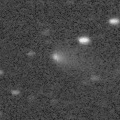
|
It brightened very rapidly, and it became brighter than expected. Now it is 15.9 mag (Sept. 20, Andrew Pearce). Fading slowly. It will be fainter than 18 mag in January. It stays observable in good condition.
Date(TT) R.A. (2000) Decl. Delta r Elong. m1 Best Time(A, h)
Sept.20 0 43.04 -3 38.4 2.419 3.402 166 16.5 0:49 ( 0, 52)
Sept.27 0 38.97 -4 11.4 2.416 3.410 171 16.5 0:17 ( 0, 51)
|

|
Now it is 16.0 mag (Sept. 12, Alfons Diepvens). It stays 17 mag for a while. In the Northern Hemisphere, it stays observable in good condition. In the Southern Hemisphere, it will never be observable after this.
Date(TT) R.A. (2000) Decl. Delta r Elong. m1 Best Time(A, h)
Sept.20 13 15.14 63 6.3 4.712 4.365 63 16.5 19:24 (148, 30)
Sept.27 13 32.44 63 9.3 4.680 4.375 66 16.5 19:14 (148, 30)
|

|
Now it is 16.7 mag (Sept. 18, Francois Kugel). It stays 17 mag for a while. It stays observable in good condition.
Date(TT) R.A. (2000) Decl. Delta r Elong. m1 Best Time(A, h)
Sept.20 19 46.18 -16 54.6 1.488 2.155 118 16.7 19:49 ( 0, 38)
Sept.27 19 50.41 -16 34.6 1.540 2.136 112 16.7 19:26 ( 0, 39)
|
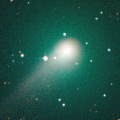
|
It was observed at 9-10 mag for a long time in 2023. It is fading very slowly. Now it is 16.4 mag (Aug. 29, ATLAS Chile). It stays 17 mag for a while. In the Northern Hemisphere, it will never be observable after this. In the Southern Hemisphere, it stays observable in good condition.
Date(TT) R.A. (2000) Decl. Delta r Elong. m1 Best Time(A, h)
Sept.20 19 2.05 -71 49.6 8.155 8.334 96 16.9 19:24 ( 1,-17)
Sept.27 18 57.68 -71 10.7 8.288 8.384 92 16.9 19:14 ( 3,-16)
|
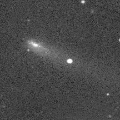
|
Now it is 16.2 mag (Aug. 30, Thomas Lehmann). Fading slowly. It will be fainter than 18 mag in November. It stays observable in good condition.
Date(TT) R.A. (2000) Decl. Delta r Elong. m1 Best Time(A, h)
Sept.20 4 2.13 4 55.6 1.900 2.513 116 16.9 4:07 ( 0, 60)
Sept.27 4 2.68 4 33.3 1.855 2.542 122 17.0 3:40 ( 0, 60)
|
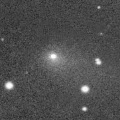
|
It brightened rapidly up to 14.6 mag in winter (Jan. 31, Thomas Lehmann). Now it is 16.9 mag (Sept. 16, ATLAS-HKO, Haleakala). Fading gradually. It will be fainter than 18 mag in November. It stays extremely low in the Northern Hemisphere. In the Southern Hemisphere, it stays observable in good condition.
Date(TT) R.A. (2000) Decl. Delta r Elong. m1 Best Time(A, h)
Sept.20 3 17.61 -35 59.5 2.225 2.869 120 17.0 3:23 ( 0, 19)
Sept.27 3 13.21 -39 17.4 2.271 2.930 122 17.1 2:51 ( 0, 16)
|
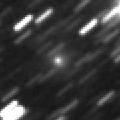
|
Very far object. Now it is 17.4 mag (July 26, ATLAS South Africa). It stays 17 mag for a while. In the Northern Hemisphere, it is not observable now, but it will appear in November. In the Southern Hemisphere, it stays observable in good condition.
Date(TT) R.A. (2000) Decl. Delta r Elong. m1 Best Time(A, h)
Sept.20 0 55.49 -57 44.6 10.356 10.920 121 17.0 1:01 ( 0, -3)
Sept.27 0 49.94 -57 44.9 10.393 10.933 120 17.0 0:28 ( 0, -3)
|

|
It will brighten up to 8 mag in winter, and will be observable in good condition. Now it is 18.4 mag (Sept. 18, W. Hasubick). It will brighten rapidly after this. In the Northern Hemisphere, it stays observable in good condition. It locates somewhat low in the Southern Hemisphere. But it will become high in winter.
Date(TT) R.A. (2000) Decl. Delta r Elong. m1 Best Time(A, h)
Sept.20 6 0.99 18 27.5 1.568 1.813 86 17.4 4:21 (299, 62)
Sept.27 6 19.06 18 51.5 1.452 1.754 89 17.0 4:27 (304, 64)
|

|
Now it is 17.1 mag (Aug. 21, Yasukazu Ikari). It stays 17 mag for a while. It will be unobservable in November. But it will be observable again in January in the Southern Hemisphere, or in December in the Northern Hemisphere.
Date(TT) R.A. (2000) Decl. Delta r Elong. m1 Best Time(A, h)
Sept.20 15 49.84 -11 28.6 6.938 6.514 61 17.0 19:24 ( 57, 22)
Sept.27 15 51.12 -11 11.9 7.033 6.506 54 17.0 19:14 ( 60, 19)
|

|
Now it is 17.0 mag (Sept. 17, Ken-ichi Kadota). Fading slowly. It will be fainter than 18 mag in December. It stays observable in good condition.
Date(TT) R.A. (2000) Decl. Delta r Elong. m1 Best Time(A, h)
Sept.20 19 45.67 -15 20.8 4.485 5.042 118 17.0 19:48 ( 0, 40)
Sept.27 19 46.54 -15 6.6 4.608 5.068 111 17.1 19:22 ( 0, 40)
|

|
Now it is 17.6 mag (Sept. 19, Alfons Diepvens). It stays 17 mag for a while. In the Northern Hemisphere, it stays observable in good condition. In the Southern Hemisphere, it will never be observable after this.
Date(TT) R.A. (2000) Decl. Delta r Elong. m1 Best Time(A, h)
Sept.20 7 31.74 72 49.0 5.197 5.145 81 17.1 4:21 (199, 45)
Sept.27 7 47.79 74 15.9 5.122 5.137 85 17.1 4:27 (196, 45)
|
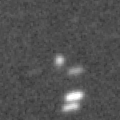
|
Brightening rapidly. It is expected to brighten up to 13 mag from 2027 to 2028. Now it is 16.8 mag (Sept. 1, Ken-ichi Kadota). It stays 17 mag for a while. In the Northern Hemisphere, it stays observable in good condition. In the Southern Hemisphere, it will be getting lower gradually after this, and it will be unobservable in December.
Date(TT) R.A. (2000) Decl. Delta r Elong. m1 Best Time(A, h)
Sept.20 21 53.31 23 53.1 6.574 7.395 142 17.1 21:55 ( 0, 79)
Sept.27 21 48.73 23 39.8 6.575 7.356 138 17.1 21:23 ( 0, 79)
|

|
Now it is 17.5 mag (Sept. 6, ATLAS-MLO, Mauna Loa). It stays 17 mag for a while. In the Northern Hemisphere, it stays observable in good condition. It stays extremely low in the Southern Hemisphere.
Date(TT) R.A. (2000) Decl. Delta r Elong. m1 Best Time(A, h)
Sept.20 5 6.22 46 12.4 3.643 3.886 96 17.2 4:21 (217, 75)
Sept.27 5 10.36 47 7.3 3.547 3.879 101 17.2 4:27 (197, 77)
|
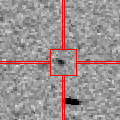
|
Now it is 17.2 mag (Sept. 17, Ken-ichi Kadota). It stays 17 mag for a while. It stays observable in good condition.
Date(TT) R.A. (2000) Decl. Delta r Elong. m1 Best Time(A, h)
Sept.20 22 28.10 -24 27.6 1.313 2.238 149 17.3 22:30 ( 0, 31)
Sept.27 22 23.22 -23 58.4 1.322 2.206 142 17.2 21:58 ( 0, 31)
|

|
It continues brightening even after the perihelion passage. Now it is 17.0 mag (Sept. 23, ATLAS Chile). It stays 18 mag for a while. In the Northern Hemisphere, it will never be observable after this. In the Southern Hemisphere, it stays observable in good condition.
Date(TT) R.A. (2000) Decl. Delta r Elong. m1 Best Time(A, h)
Sept.20 2 7.18 -67 40.9 5.201 5.615 109 17.2 2:13 ( 0,-13)
Sept.27 1 47.63 -68 24.2 5.245 5.640 108 17.3 1:26 ( 0,-13)
|

|
It brightened up to -3 mag due to the forward scattering in the SOHO coronagraph images (Oct. 9, 2024, Q.-c. Zhang, Charles S. Morris). It became a great comet of 0 mag on the ground. Now it is 17.0 mag (Sept. 7, Ken-ichi Kadota). Fading gradually. It will be fainter than 18 mag in October. In the Northern Hemisphere, it stays observable in good condition. It locates somewhat low in the Southern Hemisphere.
Date(TT) R.A. (2000) Decl. Delta r Elong. m1 Best Time(A, h)
Sept.20 17 54.07 18 14.7 5.064 5.177 90 17.2 19:24 ( 55, 64)
Sept.27 17 54.07 17 18.6 5.228 5.249 85 17.4 19:14 ( 59, 61)
|
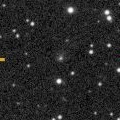
|
Now it is 17.2 mag (Mar. 6, ATLAS South Africa). It stays 17 mag for a while. It locates somewhat low in the Northern Hemisphere. In the Southern Hemisphere, it will be getting higher gradually.
Date(TT) R.A. (2000) Decl. Delta r Elong. m1 Best Time(A, h)
Sept.20 9 7.52 -14 58.1 5.127 4.445 43 17.3 4:21 (292, 5)
Sept.27 9 13.95 -16 1.4 5.075 4.447 46 17.2 4:27 (297, 9)
|
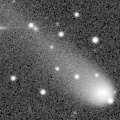
|
Now it is 17.1 mag (Sept. 2, Andrew Pearce). It stays 18 mag for a while. It stays extremely low in the Northern Hemisphere. In the Southern Hemisphere, it stays observable in good condition.
Date(TT) R.A. (2000) Decl. Delta r Elong. m1 Best Time(A, h)
Sept.20 5 59.82 -42 23.1 8.160 8.200 88 17.3 4:21 (341, 9)
Sept.27 5 57.99 -43 8.6 8.151 8.245 91 17.3 4:27 (347, 10)
|
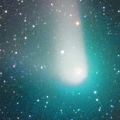
|
It brightened up to 8 mag from 2022 summer to 2023 spring. Now it is 16.9 mag (Sept. 5, Alfons Diepvens). It stays 17 mag for a while. In the Northern Hemisphere, it stays observable in good condition. It locates somewhat low in the Southern Hemisphere.
Date(TT) R.A. (2000) Decl. Delta r Elong. m1 Best Time(A, h)
Sept.20 6 20.04 28 6.7 9.651 9.573 82 17.3 4:21 (276, 63)
Sept.27 6 20.14 28 18.8 9.582 9.622 89 17.3 4:27 (283, 70)
|

|
Now it is 17.5 mag (Sept. 23, Ken-ichi Kadota). It stays 18 mag for a while. In the Northern Hemisphere, it stays observable in good condition. In the Southern Hemisphere, it will never be observable after this.
Date(TT) R.A. (2000) Decl. Delta r Elong. m1 Best Time(A, h)
Sept.20 4 22.61 76 22.3 1.800 2.118 93 17.5 4:21 (181, 49)
Sept.27 3 17.57 82 42.5 1.722 2.089 96 17.4 3:03 (180, 42)
|

|
Now it is 17.3 mag (Sept. 15, Catalina Sky Survey). It stays 17 mag for a while. In the Northern Hemisphere, it will be getting higher gradually. It stays extremely low in the Southern Hemisphere.
Date(TT) R.A. (2000) Decl. Delta r Elong. m1 Best Time(A, h)
Sept.20 9 3.44 22 0.4 2.577 2.002 45 17.5 4:21 (261, 27)
Sept.27 9 18.62 21 38.1 2.555 2.036 48 17.4 4:27 (264, 30)
|

|
Now it is 17.7 mag (Aug. 30, J. Linder). Brightening slowly. In the Northern Hemisphere, it will be getting higher gradually. In the Southern Hemisphere, it is not observable now.
Date(TT) R.A. (2000) Decl. Delta r Elong. m1 Best Time(A, h)
Sept.20 10 58.53 69 56.8 4.543 4.290 69 17.6 4:21 (203, 29)
Sept.27 11 3.78 69 44.5 4.455 4.257 72 17.5 4:27 (204, 31)
|
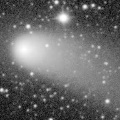
|
It brightened up to 9.6 mag from February to March in 2024 (Feb. 25, 2024, Thomas Lehmann). Now it is 17.9 mag (Sept. 17, Ken-ichi Kadota). It stays 18 mag for a while. In the Northern Hemisphere, it stays observable in good condition. It stays extremely low in the Southern Hemisphere.
Date(TT) R.A. (2000) Decl. Delta r Elong. m1 Best Time(A, h)
Sept.20 23 6.72 43 8.1 5.868 6.613 134 17.6 23:08 (180, 82)
Sept.27 23 2.69 42 27.8 5.914 6.672 136 17.6 22:37 (180, 82)
|

|
It brightened up to 11 mag in the SWAN images in early spring (Jan. 27, Vladimir Bezugly). Fading slowly. It will be fainter than 18 mag in October. It will be getting higher gradually.
Date(TT) R.A. (2000) Decl. Delta r Elong. m1 Best Time(A, h)
Sept.20 9 2.18 -7 55.9 3.022 2.381 42 17.6 4:21 (287, 10)
Sept.27 9 11.68 -9 6.4 3.029 2.441 45 17.8 4:27 (292, 14)
|

|
Now it is 17.9 mag (Sept. 23, ATLAS Chile). It stays 18 mag for a while. In the Northern Hemisphere, it will be unobservable soon. In the Southern Hemisphere, it stays observable in good condition.
Date(TT) R.A. (2000) Decl. Delta r Elong. m1 Best Time(A, h)
Sept.20 20 42.32 -53 23.9 2.412 2.982 115 17.7 20:45 ( 0, 2)
Sept.27 20 33.89 -54 41.0 2.493 2.961 108 17.7 20:09 ( 0, 0)
|

|
Now it is 17.5 mag (Sept. 23, ATLAS-MLO, Mauna Loa). It stays 18 mag for a while. In the Northern Hemisphere, it stays observable in good condition. In the Southern Hemisphere, it will never be observable after this.
Date(TT) R.A. (2000) Decl. Delta r Elong. m1 Best Time(A, h)
Sept.20 16 32.61 48 45.6 5.304 5.165 76 17.7 19:24 (127, 56)
Sept.27 16 36.28 46 49.9 5.351 5.178 74 17.7 19:14 (123, 54)
|

|
Now it is 17.8 mag (Sept. 17, Francois Kugel). It stays 18 mag for a while. It will be getting lower gradually after this, and it will be unobservable in November in the Southern Hemisphere, or in December in the Northern Hemisphere. But it will be observable again in January in the Northern Hemisphere.
Date(TT) R.A. (2000) Decl. Delta r Elong. m1 Best Time(A, h)
Sept.20 16 57.46 7 47.4 5.229 5.100 77 17.7 19:24 ( 59, 47)
Sept.27 17 1.83 6 57.2 5.300 5.085 72 17.7 19:14 ( 61, 44)
|

|
Now it is 17.3 mag (Aug. 31, Michael Jager). Fading gradually. It will be fainter than 18 mag in October. It stays observable in good condition.
Date(TT) R.A. (2000) Decl. Delta r Elong. m1 Best Time(A, h)
Sept.20 0 31.27 5 35.4 1.578 2.568 167 17.7 0:37 ( 0, 61)
Sept.27 0 26.42 4 58.3 1.587 2.588 175 17.8 0:05 ( 0, 60)
|
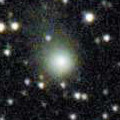
|
It brightened up to 12.1 mag in 2023 spring (May 20, 2023, Jose Guilherme de S. Aguiar). Now it is 17.4 mag (Mar. 25, ATLAS South Africa). It stays 18 mag for a while. In the Southern Hemisphere, it stays observable in good condition.
Date(TT) R.A. (2000) Decl. Delta r Elong. m1 Best Time(A, h)
Sept.20 6 42.24 -18 31.8 8.183 8.029 77 17.7 4:21 (321, 26)
Sept.27 6 42.58 -18 50.0 8.142 8.077 82 17.7 4:27 (329, 30)
|

|
Now it is 17.7 mag (June 26, ATLAS Chile). It stays 18 mag for a while. It will be getting higher gradually.
Date(TT) R.A. (2000) Decl. Delta r Elong. m1 Best Time(A, h)
Sept.20 9 11.48 -8 18.2 4.440 3.732 40 17.8 4:21 (286, 8)
Sept.27 9 15.01 -7 57.2 4.383 3.742 45 17.7 4:27 (291, 14)
|
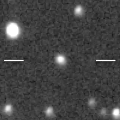
|
Although it is around 20 mag usually, now it is bright in outburst. Now it is 17.2 mag (Sept. 17, ATLAS-HKO, Haleakala). It stays 18 mag for a while. In the Northern Hemisphere, it stays observable in good condition. It stays extremely low in the Southern Hemisphere.
Date(TT) R.A. (2000) Decl. Delta r Elong. m1 Best Time(A, h)
Sept.20 3 14.57 37 55.9 8.394 8.918 118 17.9 3:20 (180, 87)
Sept.27 3 13.39 38 8.1 8.296 8.908 124 17.8 2:51 (180, 87)
|

|
Now it is 17.8 mag (Sept. 22, ATLAS South Africa). It stays 18 mag for a while. It locates somewhat low in the Northern Hemisphere. In the Southern Hemisphere, it stays observable in good condition.
Date(TT) R.A. (2000) Decl. Delta r Elong. m1 Best Time(A, h)
Sept.20 19 38.95 -22 40.4 3.534 4.072 115 17.9 19:42 ( 0, 32)
Sept.27 19 40.17 -22 25.7 3.642 4.084 109 17.9 19:15 ( 0, 33)
|

|
Now it is 17.8 mag (Mar. 17, ATLAS Chile). It stays 18 mag for a while. In the Northern Hemisphere, it will be getting higher gradually. In the Southern Hemisphere, it stays observable in good condition.
Date(TT) R.A. (2000) Decl. Delta r Elong. m1 Best Time(A, h)
Sept.20 7 39.39 -7 49.5 4.518 4.156 62 17.9 4:21 (302, 26)
Sept.27 7 44.89 -8 33.6 4.449 4.165 67 17.9 4:27 (308, 30)
|
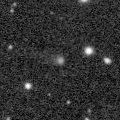
|
Now it is 18.1 mag (Sept. 22, Francois Kugel). It stays 18 mag for a while. In the Northern Hemisphere, it will be getting lower gradually. In the Southern Hemisphere, it will never be observable after this.
Date(TT) R.A. (2000) Decl. Delta r Elong. m1 Best Time(A, h)
Sept.20 15 22.44 42 32.7 5.496 5.120 63 17.9 19:24 (118, 44)
Sept.27 15 23.53 41 4.0 5.545 5.125 60 17.9 19:14 (117, 40)
|

|
Now it is 18.1 mag (Sept. 17, ATLAS-HKO, Haleakala). It stays 18 mag for a while. It stays observable in good condition.
Date(TT) R.A. (2000) Decl. Delta r Elong. m1 Best Time(A, h)
Sept.20 6 52.54 10 41.9 4.258 4.098 74 17.9 4:21 (295, 47)
Sept.27 6 57.16 10 10.3 4.168 4.108 79 17.9 4:27 (303, 52)
|
|
![]()
 164P/Christensen
164P/Christensen C/2025 J1 ( Borisov )
C/2025 J1 ( Borisov ) C/2021 S3 ( PanSTARRS )
C/2021 S3 ( PanSTARRS ) 21P/Giacobini-Zinner
21P/Giacobini-Zinner C/2025 L2 ( MAPS )
C/2025 L2 ( MAPS ) C/2024 N3 ( Sarneczky )
C/2024 N3 ( Sarneczky ) C/2024 G4 ( PanSTARRS )
C/2024 G4 ( PanSTARRS ) 486P/2024 H1 ( Leonard )
486P/2024 H1 ( Leonard ) C/2020 K1 ( PanSTARRS )
C/2020 K1 ( PanSTARRS ) C/2024 X2 ( ATLAS )
C/2024 X2 ( ATLAS ) C/2023 RS61 ( PanSTARRS )
C/2023 RS61 ( PanSTARRS ) 491P/2024 K2 ( Spacewatch-PanSTARRS )
491P/2024 K2 ( Spacewatch-PanSTARRS ) 242P/Spahr
242P/Spahr C/2023 V1 ( Lemmon )
C/2023 V1 ( Lemmon ) 276P/Vorobjov
276P/Vorobjov![]()


























































